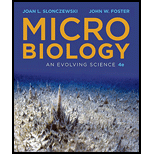
Microbiology: An Evolving Science (Fourth Edition)
4th Edition
ISBN: 9780393615098
Author: John W. Foster, Joan L. Slonczewski
Publisher: W. W. Norton & Company
expand_more
expand_more
format_list_bulleted
Concept explainers
Question
Chapter 3, Problem 3TQ
Summary Introduction
To review:
The two distinct ways used by aquatic prototroph for maximizing light access through subcellular structures also, mention the ways used by aerobes for remaining close to the surface, with access to air.
Introduction:
Prototrophs are the organisms that use sunlight along with several inorganic materials as their source of energy. It is one of the classifications of autotrophs that synthesize their food by using sunlight. Aquatic phototrophs are the phototrophic organisms that are present in water like sea, ocean, river, and lakes.
Expert Solution & Answer
Want to see the full answer?
Check out a sample textbook solution
Students have asked these similar questions
Name the 2 controlled variable
compare and contrast chloroplaasts and mitochondria from the perspectie of :
proton graddients and ATP synthesis
IDENTIFY:
A phycobilin pigment in the red algae efficient in harvesting specific wavelength of light at great depths.
Chapter 3 Solutions
Microbiology: An Evolving Science (Fourth Edition)
Knowledge Booster
Learn more about
Need a deep-dive on the concept behind this application? Look no further. Learn more about this topic, biology and related others by exploring similar questions and additional content below.Similar questions
- With the research question: Will the number of bubbles per minute increase or decrease as the light intensity increases? State your hypothesis. Explain why you expect to see these results.arrow_forward"Watermelon snow" in Antarctica is caused by a species of photosynthetic green algae that thrives in subzero temperatures (Chlamydomonas nivalis). These algae are also found in high altitude in year-round snowfields. In both locations, UV light levels tend to be high. The reddish-pink color of these algae is due to the presence of carotenoid pigments, which absorb blue light while reflecting red light. Those pigments protect the chloroplast from ultraviolet radiation, as well as absorbing heat, which provides the algae with liquid water as the snow melts around it. This molecular variation in plants illustrates a relative fitness because the molecular adaptations in chlorophyll pigments have passed to the next generation b innate variability because plants have evolved molecular differences to an environmental stimuli c unselective adaptation because plants have evolved molecular differences to adapt to different wavelengths of light d inclusive…arrow_forwardIDENTIFY: The specific photosynthetic pigment shared by the red algae with green land plants.arrow_forward
- What may be another function of the spongy layer other than photosynthesis? Also explain the cell's loose arrangement. Please explain thoroughlyarrow_forwardA flask containing an aquatic plant in water is placed next to a light. A sensor that detects the amount of dissolved oxygen is placed in the flask, and the light is set on a timer to run on a 12-hour-light, 12-hour-dark cycle for 48 hours. Explain how the amount of dissolved oxygen will change in the flask during the 12-hour-light cycle Support your explanation using information about the processes that are occurring in the flask.Explain how the amount of dissolved oxygen will change in the flask during the 12-hour-dark cycle. Support your explanation using information about the processes that are occurring in the flask.arrow_forwardDescribe the manner in which cell density regulateslight production in luminescent bacteria.arrow_forward
- Draw a basic drawing of a thylakoid membrane that is actively engaged in chemiosmosis and mark the two compartments it divides. Add the ATP synthase complex, indicate the proton gradient, and define which compartment ATP is generated in.arrow_forwardWithout this molecule to block oxygen from entering the mitochondria, the firefly would not be able to emit light .arrow_forwardInside the thylakoid is a fluid-filled space calledarrow_forward
- Draw a simple sketch illustrating a thylakoid membrane that is actively involved in chemiosmosis and label the two compartments it separates. Add the ATP synthase complex, indicate the proton gradient, and specify inwhich compartment ATP is synthesized.arrow_forwardName the organisms and their respective pigments absorbing solar energy in visible spectrumarrow_forward10°C water 25 °C water 40 °C water Lumes number of bubbles released number of bubbles released number of bubbles released 0 3 7 3 1000 11 23 11 2000 17 35 17 3000 19 39 19 Why are bubbles counted in this experiment, and what do they represent? make a line graph showing the difference in the number of oxygen gas bubbles released by the plant under different light intensities and water temperatures. Which light intensity and water temperature caused the plant to produce the most amount oxygen gas during the process of photosynthesis? Why Which light intensity and water temperature caused the plant to produce the least amount oxygen gas during the process of photosynthesis? Why?arrow_forward
arrow_back_ios
SEE MORE QUESTIONS
arrow_forward_ios
Recommended textbooks for you
 Biology Today and Tomorrow without Physiology (Mi...BiologyISBN:9781305117396Author:Cecie Starr, Christine Evers, Lisa StarrPublisher:Cengage Learning
Biology Today and Tomorrow without Physiology (Mi...BiologyISBN:9781305117396Author:Cecie Starr, Christine Evers, Lisa StarrPublisher:Cengage Learning Principles Of Radiographic Imaging: An Art And A ...Health & NutritionISBN:9781337711067Author:Richard R. Carlton, Arlene M. Adler, Vesna BalacPublisher:Cengage Learning
Principles Of Radiographic Imaging: An Art And A ...Health & NutritionISBN:9781337711067Author:Richard R. Carlton, Arlene M. Adler, Vesna BalacPublisher:Cengage Learning Concepts of BiologyBiologyISBN:9781938168116Author:Samantha Fowler, Rebecca Roush, James WisePublisher:OpenStax College
Concepts of BiologyBiologyISBN:9781938168116Author:Samantha Fowler, Rebecca Roush, James WisePublisher:OpenStax College

Biology Today and Tomorrow without Physiology (Mi...
Biology
ISBN:9781305117396
Author:Cecie Starr, Christine Evers, Lisa Starr
Publisher:Cengage Learning

Principles Of Radiographic Imaging: An Art And A ...
Health & Nutrition
ISBN:9781337711067
Author:Richard R. Carlton, Arlene M. Adler, Vesna Balac
Publisher:Cengage Learning

Concepts of Biology
Biology
ISBN:9781938168116
Author:Samantha Fowler, Rebecca Roush, James Wise
Publisher:OpenStax College
Photosynthesis & Respiration | Reactions | Chemistry | FuseSchool; Author: FuseSchool - Global Education;https://www.youtube.com/watch?v=3XIyweZg6Sw;License: Standard YouTube License, CC-BY